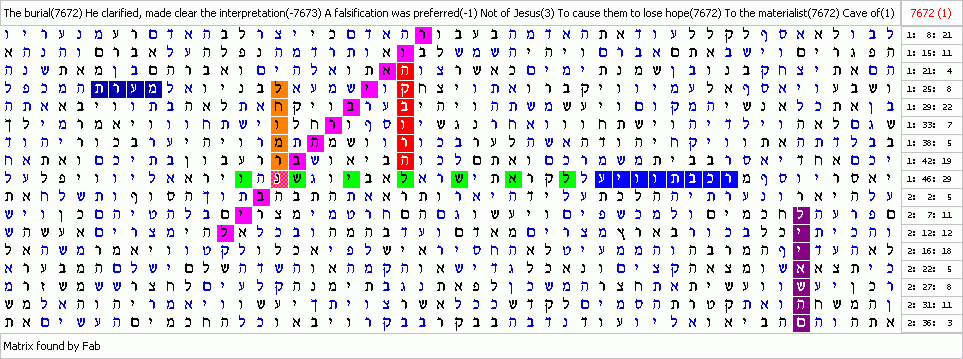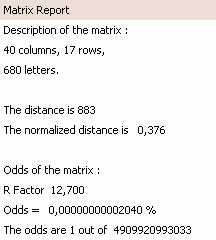
Code by Fab (22/Sept/08)
The burial - Does not belong to Jesus.



This one was found by running a separate search for 3 terms making up the other Hebrew spelling of the expression "The Lost Tomb of Jesus". The best meeting of these 3 terms yielded the following additional terms: The main term "the Lost" could be extended "the Lost is from the adversary/enemy/foe". "The Tomb" to "name of the Tomb". And "of Jesus" to "not of Jesus" (or "does not belong to Jesus") again. I also noticed the expression from the surface text "in the end of days" in the near vicinity. The term "the Tomb" could be found in a related verse from Genesis (49:31) stating: "There they buried Abraham and Sarah his wife; there they buried Isaac and Rebekah his wife; and there I buried Leah."
In this second matrix on the the same topic, I also found 2 terms already found in the first one: "a falsification/distortion was preferred", "to cause to lose hope": http://en.wikipedia.org/wiki/The_Lost_Tomb_of_Jesus -
I found 2 matrixes on the so-called "Lost Tomb of Jesus". Personally, I didn't pay too much attention to this so-called "discovery" (which is not something new at all actually, see the Wikipedia article on the "Talpiot Tomb": http://en.wikipedia.org/wiki/Talpiot_Tomb), and tended to regard it as nothing more than just another "Da Vinci code" and a good way to "make big bucks", as they say, but it looks like many people seem to believe seriously there might be something to it. Since the claims of both the documentary and the book "The Jesus Family Tomb" (http://en.wikipedia.org/wiki/The_Jesus_Family_Tomb) call into question the most basic tenets of the teachings of the NT (particularly the resurrection), I thought it was important to clarify a few things...:
To sum up, the main claim of the documentary and the book, is that Jesus' bones were found in a tomb near Jerusalem (Talpiot) along with those of His "family". So, if these claims were true, it would prove that:
1) Jesus' bodily resurrection is a lie (since His so-called bones would have been found), although the NT (the idea of a resurrected Messiah among the Jews predates the NT, there is now archeological evidence outside the Bible to back this up: http://en.wikipedia.org/wiki/Gabriel%27s_Revelation) makes it clear that He had to die and be raised from the dead in order to fulfill the prophecies, Jesus Himself asserted this:
Matthew 17:9: "And as they came down from the mountain, Jesus charged them, saying, 'Tell the vision to no man, until the Son of man be risen again from the dead'." (see also Mark 9:9)
Luke 24 explicitly shows He was bodily resurrected (it was not just a spiritual metaphor then):
Luke
24:2: "And they found the stone rolled away from the sepulchre.
3 And they entered in, and found not the body of the Lord
Jesus.
4 And it came to pass, as they were much perplexed thereabout,
behold, two men stood by them in shining garments:
5 And as they were afraid, and bowed down their faces to the earth,
they said unto them, 'Why seek you the living among the dead?
6 He is not here, but is risen: remember how
He spake unto you when He was yet in Galilee"
44:
"And He said unto them, 'These are the words which I spake unto you,
while I was yet with you, that all things must be fulfilled,
which were written in the law of Moses, and in the prophets, and in
the psalms, concerning Me.'
45 Then opened He their understanding, that they might understand
the scriptures,
46 And said unto them, 'Thus it is written, and thus it
behoved Christ to suffer, and to rise from the dead the third day'"
Corresponding passages from the OT:
Psalms 16:10: "For You will not leave My soul in hell; neither will You suffer Your Holy One to see corruption."
Confirmed by Peter (see Acts 2:27 and 31), and Paul (see Acts 13:29-37).
The angel also confirmed this:
Matthew
28:5: "And the angel answered and said unto the women, 'Fear not you:
for I know that you seek Jesus, which was crucified.
6 He is not here: for He is risen, as He said.
Come, see the place where the Lord lay.
7 And go quickly, and tell his disciples that he is risen
from the dead; and, behold, He goes before you into Galilee;
there shall you see Him: lo, I have told you'."
And Paul makes very clear that Jesus' resurrection is a central tenet of the Gospel, and without it all the rest falls apart:
1
Corinthians 15:12: "Now if Christ be preached that He rose from
the dead, how say some among you that there is no resurrection of the
dead?
13 But if there be no resurrection of the dead, then is
Christ not risen:
14 And if Christ be not risen, then is our preaching vain,
and your faith is also vain.
15 Yea, and we are found false witnesses of God; because
we have testified of God that He raised up Christ: whom He raised not
up, if so be that the dead rise not.
16 For if the dead rise not, then is not Christ raised:
17 And if Christ be not raised, your faith is vain; you
are yet in your sins.
18 Then they also which are fallen asleep in Christ are
perished.
19 If in this life only we have hope in Christ, we are
of all men most miserable.
20 But now is Christ risen from the dead, and become
the firstfruits of them that slept."
The Shroud of Turin being another evidence, to me:
http://shroudstory.com/faq-miracle.htm
Is
it possible to think that Jesus' body, at the moment of resurrection,
became mechanically transparent thus enabling a cloth to fall through
it (or the body to pass through the cloth). This idea might
be comfortable for some biblical exegetes who identify with passages
in John's Gospel. Historian and biblical scholar N. T. Wright in The
Resurrection of the Son of God (London: SPCK, 2003) illustrates
this thinking:
The beloved disciple came to his new belief, the text wants us to understand:
not simply on the basis of the emptiness of the tomb (which had been
explained by Mary in verse 2 in terms of the removal of the body to
an unknown location), but on the basis of what he deduced both from
the fact that the grave-clothes had been left behind and from the position
in which they were lying. He, like Thomas at the end of the chapter,
saw something which elicited faith. The fact that the grave-clothes
were left behind showed that the body had not been carried off, whether
by foes, friends or indeed a gardener (verse 15). Their positioning,
carefully described in verse 7, suggest that they had not been unwrapped,
but that the body had somehow passed through them, much as,
later on, it would appear and disappear through locked doors (John 20:19
and 26).
This is speculation. Yet it resonates with the collimated appearance of the images and the topographical spatial information that can be plotted as three-dimensional images. It is also consistent with something that forensic experts tell us. The body images show no visible signs of decomposition and the linen fabric is not damaged by any bodily decomposition products. It is also consistent with a baffling observation about the bloodstains. Dried blood, in acting like weak glue between body and cloth, should have cracked and broken apart if the body was unwrapped by convention physical means. Small fibers of blood-soaked linen should have pulled apart. Yet this not observed in the bloodstains.
2) Jesus had a son (one of the ossuaries bears the name (according to some disputed interpretations: http://en.wikipedia.org/wiki/The_Lost_Tomb_of_Jesus#Ossuary_inscriptions, http://en.wikipedia.org/wiki/The_Lost_Tomb_of_Jesus#Interpretation_of_the_inscriptions) "Yehuda bar Yeshua", possibly Aramaic for "Judah son of Jesus"). There would be nothing wrong about this, except that it clearly contradicts the Bible:
According to Raphael Lataster in his (excellent) book "Was the New Testament Really Written in Greek?" (Chap 4. Semitic Idioms) available as a free download here: http://www.aramaicpeshitta.com/downloadbook.htm
The KJV says: “In His humiliation His judgment was taken away: and who shall declare His generation? For His life is taken from the earth.
"Who will declare His generation?" is an idiom meaning roughly in English "His line was cut off". In other words, Yeshua has no living relatives or descendants... and that's the context of the passage being quoted in Isaiah (please note that many anti-Peshitta campaigners claim that the Peshitta is favored by cultists and Gnostics – this revelation that Yeshua had no children directly contradicts the widespread Gnostic teaching that He and Mary Magdalene had children together). In Semitic thought, "generation" is inextricably linked with genetic line, offspring. It's not like the English which means only an "age" or "period of time." When Matthew and Luke recorded the genealogy of Yeshua, it stopped with Him. There is no one after Him. This is the meaning of the Isaiah prophecy in Isaiah 53:8 – "who will speak of His descendants (generations)?" Isaiah teaches us that Yeshua would be "cut off" without any descendents or line of continuation... no "generations"..."
http://en.wikipedia.org/wiki/The_Lost_Tomb_of_Jesus#Contradictions_with_Christian_views
Also, the claim that Jesus was married also undermines the theological metaphor of the Church being the "Bride of Christ" (found in the writings of the New Testament). Jimmy Akin, director of Apologetics and Evangelization at Catholic Answers, wrote: "This image would never have arisen if there was a Mrs. Jesus living right there in Jerusalem.... We know about [the wives of religion founders] because they were honored figures as wives of The Founder, and if Jesus had a wife then (a) we would know about it and (b) the whole Church-as-the-Bride-of-Christ metaphor would never have come into existence." As for a possible "son of Jesus," he noted: "We tend to know about even the daughters of religious founders. Muhammad's daughter Fatima comes to mind. It would be much harder to sneak a forgotten son by the eyes of history…. It's not just hard to sneak sons past because patriarchal cultures focus more on sons; it's also because of this: In traditional societies, the son is looked on as the father's natural successor."
And not only are some the names on the bone boxes relatively common names, but no writings of Jesus' life, canonical or apocryphal, reported a marriage or children: http://en.wikipedia.org/wiki/The_Jesus_Family_Tomb#Controversy